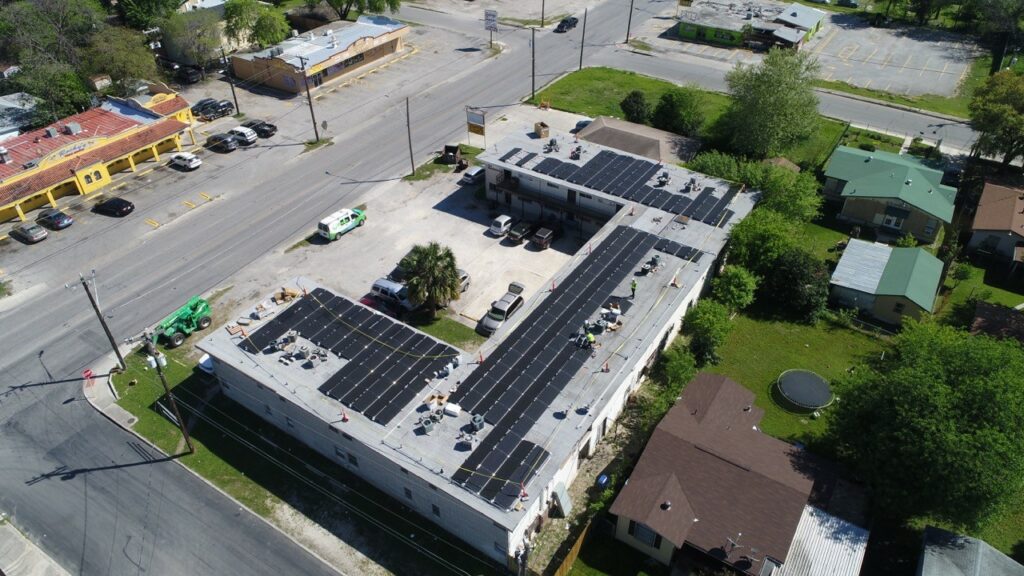
By Ron Zagarri, TXSES
November 2019
Ramesh Mahbubani, “RK” to his friends, was born and raised in North Africa and attended school there, as well as in England and India, prior to immigrating to the United States. He graduated from Drake University in Iowa and found his way to San Antonio in 1985 when his wife took a position with the San Antonio Independent School District.
Although he knew very little about rooftop solar (“My familiarity with photovoltaics was a one on a scale of one to ten—maybe even lower,” he admitted), RK and his wife decided to install solar on their home. They met with several solar companies in the summer of 2016. After evaluating the proposals, the couple began to appreciate the compelling economic advantages rooftop solar could provide.
They quickly realized solar might also make sense on one of their investment properties, a twenty-unit residential apartment complex. They chose Wells Solar for the commercial install and executed the contract in August.
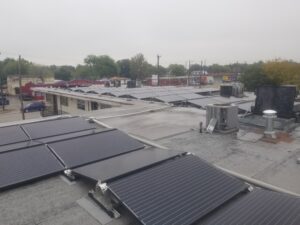
Array closeup.
In a series of interviews, we discussed RK’s experience with installing a commercial solar system in the San Antonio business environment. This article has been edited for clarity and length.
Ron: When you began this process, how familiar were you with the economic and technical aspects of photovoltaics as it applies to a commercial building?
RK: Not familiar at all. But the process of meeting with several people in the industry has helped me understand it a little. My technical knowledge is still very limited.
Ron: Tell us a little about the system itself. What is the total capacity, the number of panels, and panel type?
RK: The initial proposal was for a 62.44 kW system with 223 Hanwha Q CELLS modules. The expected first-year production was 81,743 kWh. However, the installer chose to use a different, more efficient panel at the time of install.
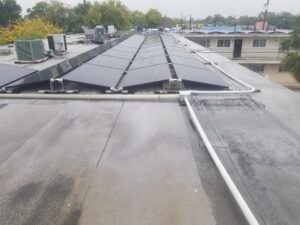
East/west module orientation. Working around roof obstructions.
Ron: How are the panels oriented?
RK: The panels were installed in a bidirectional basis, oriented both east and west. There are no other structures or trees that can create shadowing effects, so this was considered to be the optimal positioning consistent with the roof layout.
Embracing the Challenge
Ron: Commercial properties present some unique challenges and opportunities that we do not typically see in single-family residential systems. Let’s first talk about your motivation to even consider this project.
RK: The primary motivation was financial. After experiencing the positive effect solar had on our residential energy bill, we figured we could successfully translate that to a commercial property.
Ron: The apartment complex has a flat roof. How was the system installed to take advantage of that feature?
RK: Due to the flat roof, I did not want any roof penetrations for fear of water leaks. The system is ballasted. We had to work around a lot of HVAC systems and vent piping, as you can see in the photos. Also, with a ballasted system, it should be easier to temporarily remove a section of the system in the future in case a roof repair is needed.
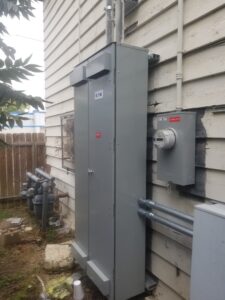
New main electrical panel and meter.
Ron: Multi-family residential properties present some metering and billing complications in terms of how the solar energy is apportioned to each household. Did you face this issue?
RK: Fortunately, no. One important element that made this particular property a good candidate for solar is that all utilities are included in the apartment rent, so there is just one electric meter and one utility bill that I, as the owner, pay.
Economics
Ron: Let’s talk about some of the financial considerations. What was it like working with CPS Energy, the municipal electric provider, and their solar rebate program?
RK: At the time of contracting, CPS was offering a 28 percent rebate, which was later increased to 32 percent. Of course, that is not counting additional credits at the federal level of 30 percent on the balance. So our out-of-pocket cost ended up at around $60,000. Since this was a business investment, we can depreciate that amount over a very short period of time, approximately five years. In comparison, the solar panels should be producing for at least twenty-five years, hopefully as much as forty years
Ron: How did all that pencil out on a payback period basis?
RK: Our annual pre-solar electricity expenses were about $14,600. In the first post-solar year, our electric bills totaled $11,000 and $10,700 in the second year. If this trend of $11,000 continues, we will realize at least $3,000 to our bottom line on an annual basis, probably more as electricity rates continue to rise. With the cost of the panels depreciated out after five years, this will offer a great added benefit. So the financials indicate our payback period will occur in three to four years, probably 2021 at the latest.
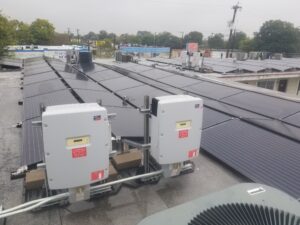
Modules and string inverters.
Ron: That is a very convincing economic argument that commercial property owners need to hear. Tell us a little about the installation process. You mentioned you spent a year from start to finish. Is that a realistic time frame for other businesses, like a small hotel for example, to consider a similar project?
RK: I believe this is a realistic time frame. The initial paperwork with the utility company began in September 2016 and in March 2017, the installation occurred. On August 23, 2017, I finally received an email from the utility company granting permission to operate the system.
The utility company required several engineering reports and diagrams before granting approval. Due to the age of the electric service equipment, the main service panel had to be replaced. Then the lines from the service panel to the utility pole had to be replaced, again due to age.
Getting paperwork approval from the city and utility company took the most time, since these two entities were not always on the same page. Once the approvals were processed, the installer completed the system within ten days. After the panels were installed, there was a further delay. The utility company did not have the correct CT converters on hand, and those had to be ordered. But at the end of the day, this was definitely a worthwhile project.
Ron: Knowing what you know now, would you do it again? Perhaps on one of your other commercial properties?
RK: If I had another property where I was paying the entire electric bill, I would not hesitate to install solar panels again. Working with Wells Solar has been easy. They are always available to answer questions and concerns, and they worked very hard to get our project completed.
Ron Zagarri serves on the TXSES board and is editor of the Solar Reflector.
